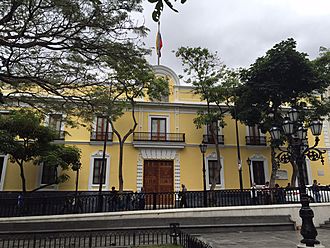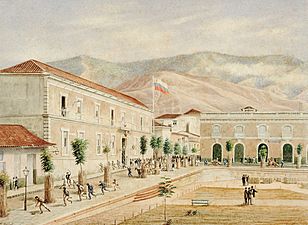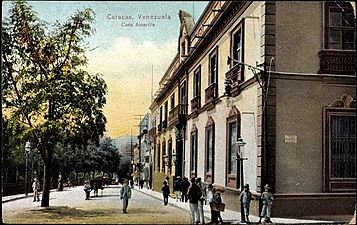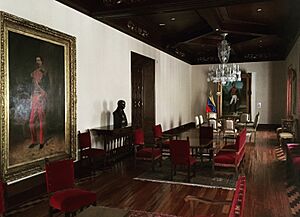Yellow House (Venezuela) facts for kids
Quick facts for kids Casa Amarilla |
|
|---|---|
 |
|
| General information | |
| Location | Plaza Bolívar, Caracas |
| Design and construction | |
| Architect | Juan Hurtado Manrique |
The Casa Amarilla de Caracas, which means Yellow House in English, is a beautiful old building in Plaza Bolívar, Caracas. It stands right in front of the Santa Ana Cathedral in the city's main historic area. This building was built in the 1800s and has a classic, grand style.
At first, the Yellow House was used as a jail and a meeting place for the city's leaders. Later, it became a palace where some Venezuelan presidents, like Francisco Linares Alcántara and Cipriano Castro, lived and worked. Since 1912, it has been the main office for the Ministry of Foreign Affairs, which handles Venezuela's relationships with other countries. Because of its important history, the Yellow House was named a National Historical Monument on February 16, 1979.
Contents
History of the Yellow House
Early Days and City Council
The first maps of Caracas, made around 1578, show that the spot where the Yellow House now stands was once a simple house. In 1689, the city bought part of this land to build a new city prison, which opened in 1696. Later, in 1704, the city council got the rest of the land. They then built their new main office there, finishing it in December 1750.
A Key Moment for Independence
The House of the Cabildo (City Council) was very important on April 19, 1810. On that day, a brave leader named José Cortés de Madariaga stood on its balconies. He signaled to the people of Caracas to reject the Spanish ruler, Vicente Emparán. This event was the first big step towards Venezuela's independence from Spain. Records of this important day are kept in the Municipal Palace.
Rebuilding After the Earthquake
A strong earthquake hit Caracas on March 26, 1812. It badly damaged the Yellow House, leaving it in ruins for many years. It took four years to rebuild the building. In 1841, the government decided to buy both the prison and the city council buildings. They planned to use them as the main government office. After being fixed up, the building officially reopened in 1842. This happened during the time General José Antonio Páez was president.
Becoming the Government Palace
In 1874, President Antonio Guzmán Blanco ordered a big change for the building. He wanted it to become the Government Palace. The architect Juan Hurtado Manrique led the renovation work. He also built a special memorial on the south side to remember the 1810 independence event. The new Government Palace opened on November 7, 1874. On the same day, a statue of Simón Bolívar was also revealed in the nearby square, which was then named after him.
The Yellow House Gets Its Name
In 1877, the National Congress decided that the Government Palace would be the official home for the President. General Francisco Linares Alcántara was the first president to live there. The building was painted yellow, which was the color of the Liberal Party at the time. Because of its color, people started calling it the "Yellow House" in official papers.
Changes Over Time
During an earthquake on October 28, 1900, President Cipriano Castro was living in the Yellow House. He jumped out of a balcony with an umbrella and broke his ankle! This made him think about moving to a building that was safer from earthquakes. So, in 1904, the President's official home moved to Miraflores Palace.
After that, the Yellow House was used by the High Court and the Government of Caracas. Finally, on October 28, 1912, President Juan Vicente Gómez declared that the building would become the headquarters for the Ministry of Foreign Affairs. In 1989, a fire on the second floor damaged some of the building's valuable art.
Architecture of the Yellow House
The Yellow House has a very organized design. It is shaped like a square and has two floors. Inside, there is a central open courtyard. This courtyard is surrounded by a terrace and a balcony on both floors. These areas have tall, classic columns that support a series of arches.
The building has several important rooms used for official events. One of the most famous is the Bolívar Room. This large room takes up the entire front part of the second floor.
See also
 In Spanish: Casa Amarilla de Caracas para niños
In Spanish: Casa Amarilla de Caracas para niños




